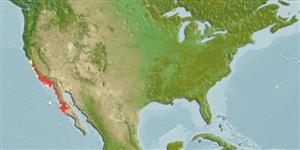Environment: milieu / climate zone / depth range / distribution range
Ökologie
seewasser demersal; tiefenbereich 18 - 256 m (Ref. 2850). Subtropical; 39°N - 26°N, 124°W - 113°W
Eastern Central Pacific: San Francisco, California, USA to central Baja California, Mexico.
Length at first maturity / Size / Gewicht / Alter
Maturity: Lm 9.0 range ? - ? cm
Max length : 25.0 cm TL Männchen/unbestimmt; (Ref. 9015); max. veröff. Alter: 12 Jahre (Ref. 39247)
Kurzbeschreibung
Bestimmungsschlüssel | Morphologie | Morphometrie
Rückenflossenstacheln (insgesamt) : 12 - 14; Rückenflossenweichstrahlen (insgesamt) : 12 - 14; Afterflossenstacheln: 3; Afterflossenweichstrahlen: 6 - 7; Wirbelzahl: 26 - 27. Branchiostegal rays: 7 (Ref. 36715).
Adults occur on or near soft bottom (Ref. 2850). Viviparous, with planktonic larvae and pelagic juveniles (Ref. 36715).
Eschmeyer, W.N., E.S. Herald and H. Hammann, 1983. A field guide to Pacific coast fishes of North America. Boston (MA, USA): Houghton Mifflin Company. xii+336 p. (Ref. 2850)
IUCN Rote Liste Status (Ref. 130435)
Nutzung durch Menschen
Fischereien: kommerziell
Tools
Zusatzinformationen
Download XML
Internet Quellen
Estimates based on models
Preferred temperature (Ref.
123201): 9.7 - 14.8, mean 10.8 °C (based on 10 cells).
Phylogenetic diversity index (Ref.
82804): PD
50 = 0.5000 [Uniqueness, from 0.5 = low to 2.0 = high].
Bayesian length-weight: a=0.01000 (0.00499 - 0.02004), b=3.09 (2.92 - 3.26), in cm total length, based on LWR estimates for this Genus-body shape (Ref.
93245).
Trophic level (Ref.
69278): 3.6 ±0.5 se; based on size and trophs of closest relatives
Widerstandsfähigkeit (Ref.
120179): niedrig, Verdopplung der Population dauert 4,5 - 14 Jahre. (tmax=12; tm=3).
Fishing Vulnerability (Ref.
59153): Low vulnerability (15 of 100).
